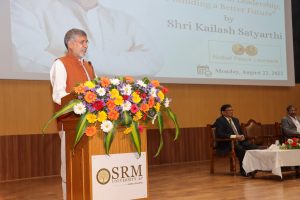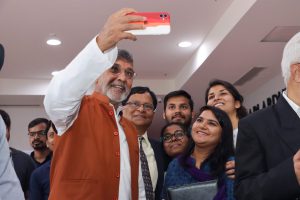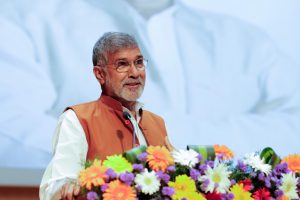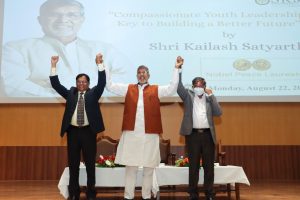SRM-AP All News
ALL News
- Digital re-skilling: CR&CS inks MoU with Infosys Limited – Springboard Platform August 24, 2022
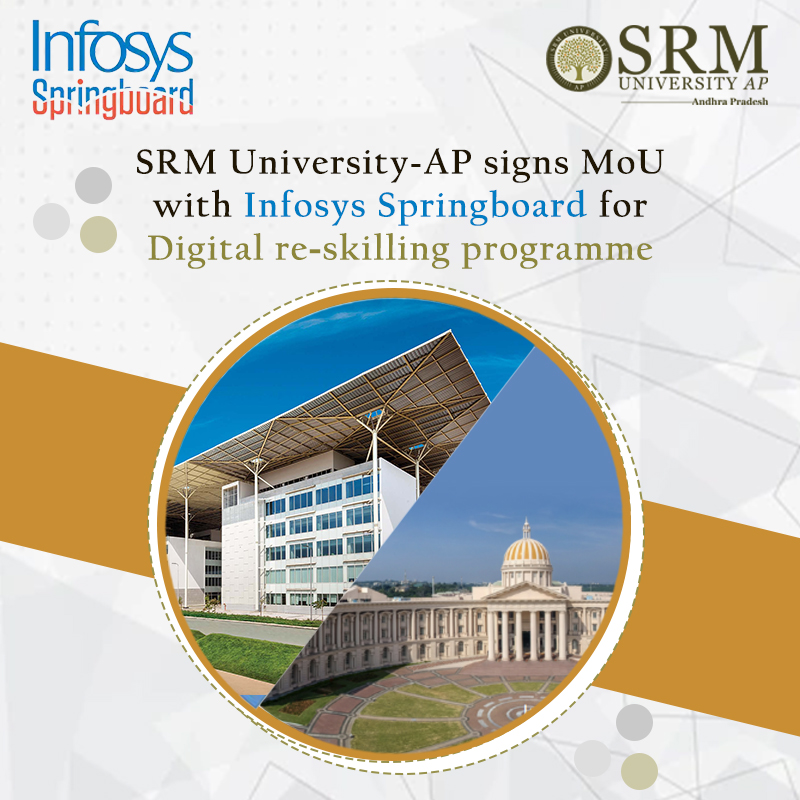 SRM university-AP collaborates with Infosys Limited – Springboard to expand the digital re-skilling of engineering students. This collaboration will benefit the students who belong to BTech, MTech, and BSc programmes.
SRM university-AP collaborates with Infosys Limited – Springboard to expand the digital re-skilling of engineering students. This collaboration will benefit the students who belong to BTech, MTech, and BSc programmes.The holistic set of courses is also fully aligned with India’s National Education Policy 2020. The learning program is particularly well-suited for growing vocational skills in addition to soft skills. This will enable the students of SRM university-AP to meet the updating standards of the job market. Masterclasses, programming challenges, practice areas, and playgrounds for experimentation will make the training immersive for the students.
The university has been focusing on these core areas in order to expose the students to versatile and skill-demanding career opportunities. Since its establishment, SRM University-AP has been an innovator in higher education, reaching out to promising students, embracing the novelties in learning methods, and promoting a global vision. The institution leaves no stone unturned in accelerating the enthusiasm of students to approach learning from various vantage points beyond formal education. The collaboration fabricates a broader arena for the university to exert pathbreaking thoughts and actions.
Continue reading → - Dr Uma Maheswar to work on an overseas-funded project August 24, 2022
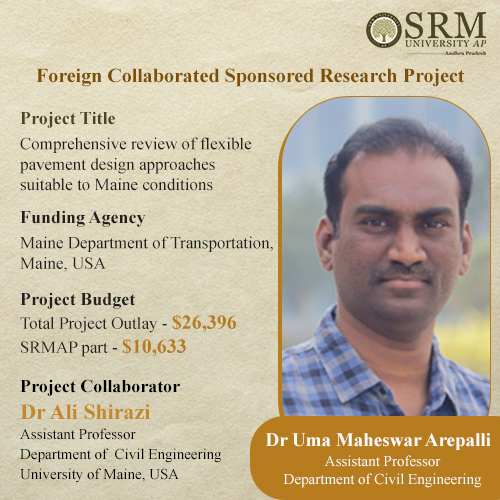
Yet another moment of pride and honour for SRM University-AP as Dr Uma Maheswar Arepalli, Assistant Professor, Department of Civil Engineering in collaboration with Dr Ali Shirazi, Assistant Professor, Department of Civil Engineering, University of Maine, USA received a research project award from the Maine Department of Transportation, Maine, USA. The project titled “Comprehensive review of flexible pavement design approaches suitable to Maine conditions” received a total project outlay of $26,396 (Rs. 21.12 Lakhs).
This is the first of its kind project in India that receives funding directly from the foreign (United States) entity unlike the typical Department of Science & Technology (DST) International Bilateral Joint Project Schemes. This 8-month-long project will review the various existing flexible pavement design approaches in the USA and will provide recommendations to the Department of Transportation on a suitable design approach conducive to the conditions of Maine.
The outcome of the project will help the Department of Transportation to decide on a suitable pavement design approach that enhances the performance of pavements in Maine. The project engenders an opportunity for two under-graduate students of SRM University-AP to work as paid interns and receive international exposure in their prospective research areas. It also involves the scope for industry translatory research.
Continue reading → - VS2-BP hybrid electrode material for supercapacitor applications August 24, 2022
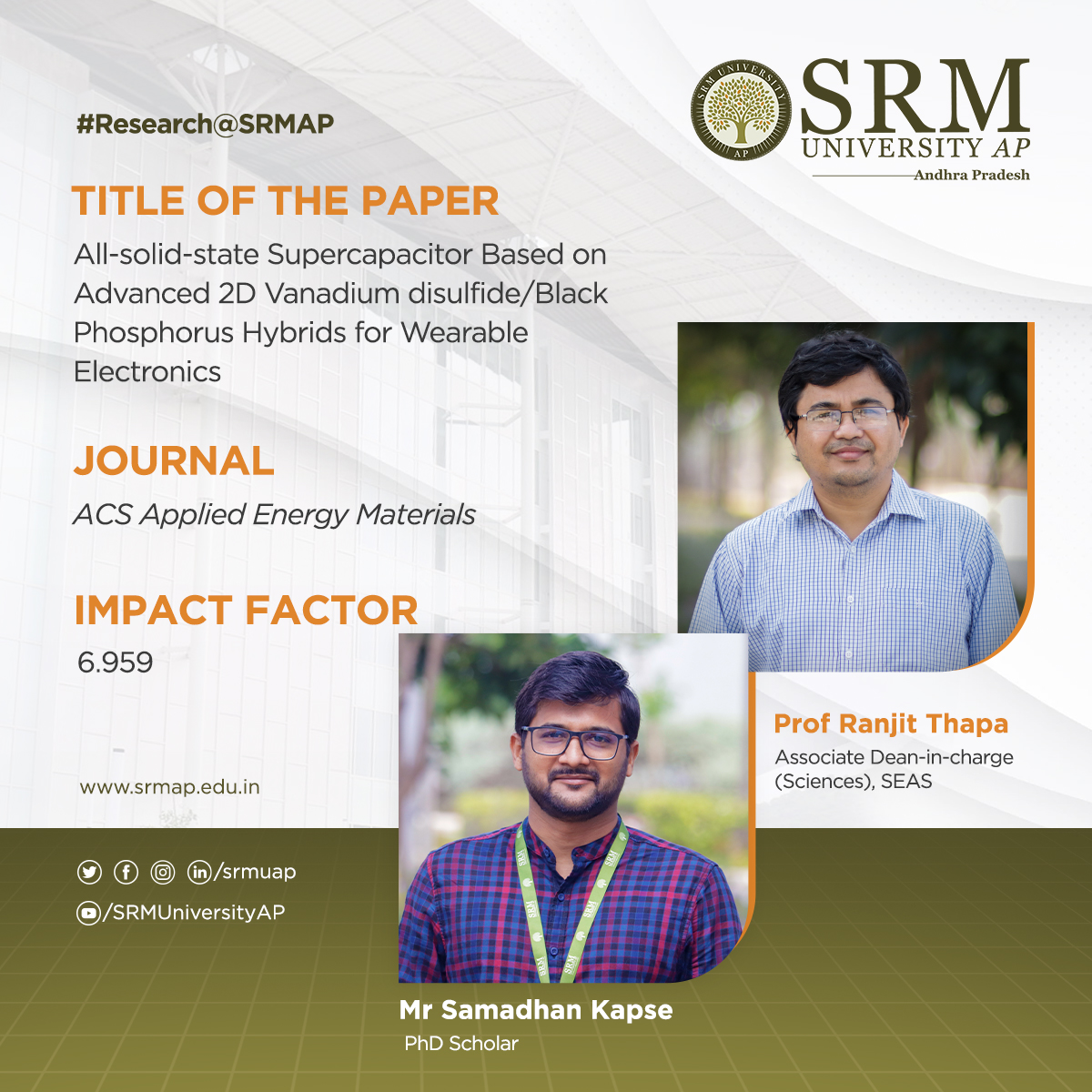 A theoretical investigation is highly important to investigate the properties of materials, the origin of selectivity, and the effect of various parameters in designing promising electrode materials for supercapacitor applications. The latest research paper by Mr Samadhan Kapse, PhD Student in the Department of Physics, and Prof Ranjit Thapa, Associate Dean of SEAMS (Sciences), envisions this and developed a novel VS2-BP hybrid electrode material. Their article titled All-solid-state Supercapacitor Based on Advanced 2D Vanadium disulfide/Black Phosphorus Hybrids for Wearable Electronics has been published in the journal ACS Applied Energy Materials with an impact factor of 6.959.
A theoretical investigation is highly important to investigate the properties of materials, the origin of selectivity, and the effect of various parameters in designing promising electrode materials for supercapacitor applications. The latest research paper by Mr Samadhan Kapse, PhD Student in the Department of Physics, and Prof Ranjit Thapa, Associate Dean of SEAMS (Sciences), envisions this and developed a novel VS2-BP hybrid electrode material. Their article titled All-solid-state Supercapacitor Based on Advanced 2D Vanadium disulfide/Black Phosphorus Hybrids for Wearable Electronics has been published in the journal ACS Applied Energy Materials with an impact factor of 6.959.Abstract
Vanadium disulfide-Black Phosphorus (VS2-BP) hybrids were synthesised by a one-pot hydrothermal assisted method to achieve enhanced electrochemical activity for supercapacitor applications. The concentration of BP was optimised to prevent the restacking nature of VS2 and to enrich the active edges for electrolytic ion intercalation. The charge storage kinetics of the best-performing VS2-BP as an active electrode has demonstrated the dominance of the pseudocapacitive nature of the material. Further, by sandwiching with PVA/K2SO4 gel electrolyte, an all-solid-state (ASS) Vanadium disulfide/Black Phosphorus-50 mg (VS2-BP-50) symmetric device was developed on highly conductive carbon paper. The ASS VS2-BP-50 symmetric device displays the highest specific areal capacitance of 203.25 mF/cm2. It exhibits the maximum areal energy density of 28.22 µW h cm-2 at an areal power density of 596.09 mW cm-2, outperforming previous literature. We used density functional theory to understand the origin of high quantum capacitance. We found that the charge accumulation region between VS2 and BP monolayers and the charge transfer is the origin of the improved density of states in the VS2-BP hybrid. Also, we observed the higher mobility of K+ ion and a higher diffusion rate using the Density functional theory (DFT) method.
Explanation of the research
A novel VS2-BP hybrid electrode material was prepared using a simple hydrothermal approach. Due to a synergistic effect, it was discovered that adding BP to metallic VS2 enhances the number of electrochemically active sites, resulting in increased surface activity. It also accelerates reaction kinetics with electrolyte ions by improving the electrical behaviour of active electrode material. As a result, the hybrid technique overcomes the weaknesses of individual components during electrochemical processes, resulting in increased performance that has been limited by individuals. The BP nanosheets behaved as a pore region for electron transport and prevented the VS2 layers from re-stacking. Systematic experiments are conducted by selecting the ideal precursor ratios to generate a high-quality VS2-BP hybrid with enhanced electronic conductivity. Furthermore, in the overall collective charge storage of the VS2-BP-50 hybrid material, the present results demonstrated that capacitive contributions outnumber diffusive contributions. The ASS VS2-BP-50 symmetric supercapacitor device was also designed to have a high areal capacitance of 203.25 mF/cm2 with a maximum areal power density of 596.09 mW cm-2. The extraordinary performance of the ASS VS2-BP-50 symmetric device illustrates its versatility in terms of designing a high-power density ASS supercapacitor for flexible and wearable device applications. The work functions of BP, VS2, and VS2-BP are 0.73 eV, 5.37 eV, and 4.99 eV, respectively, which help in the charge transfer mechanism and increase the density of state at the Fermi level, and subsequently, the quantum capacitance of the heterostructure.
Collaborations
1. Mr Aditya Sharma, Centre for Nano and Material Sciences, Jain Global Campus, Jakkasandra, Ramanagaram, Bangalore – 562112, Karnataka, India
2. Mr Ankur, Centre for Nano and Material Sciences, Jain Global Campus, Jakkasandra, Ramanagaram, Bangalore – 562112, Karnataka, India
3. Mr Sagar Bisoyi, Department of Physics, School of Applied Sciences, KIIT Deemed to be University, Bhubaneswar-751024, Odisha, India.
4. Dr Gopal K. Pradhan, Department of Physics, School of Applied Sciences, KIIT Deemed to be University, Bhubaneswar-751024, Odisha, India.
5. Dr Chandra Sekhar Rout, Centre for Nano and Material Sciences, Jain Global Campus, Jakkasandra, Ramanagaram, Bangalore – 562112, Karnataka, India
Social implications of the research
With the exponential development of portable/flexible electronics and the high demand for renewable energy, conventional energy-storage devices, such as supercapacitors, have attracted attention due to their benefits of fast charge/discharge rates, long cycle life, and high-power density. Similarly, developing novel functional materials with exceptional qualities could shed light on a plethora of challenges, including environmental pollution, energy crisis, etc. Two-dimensional (2D) layered materials, such as metallic 1T MoS2 single layers, SnSe2, MXenes, and black phosphorous (BP), have been intensively studied for supercapacitor applications. These materials benefit from efficient ion intercalation and electrosorption. The two-dimensional (2D) layered transition-metal dichalcogenides (TMDs) have recently piqued the scientific community’s curiosity.
- Patient’s E Healthcare Records Management System August 23, 2022
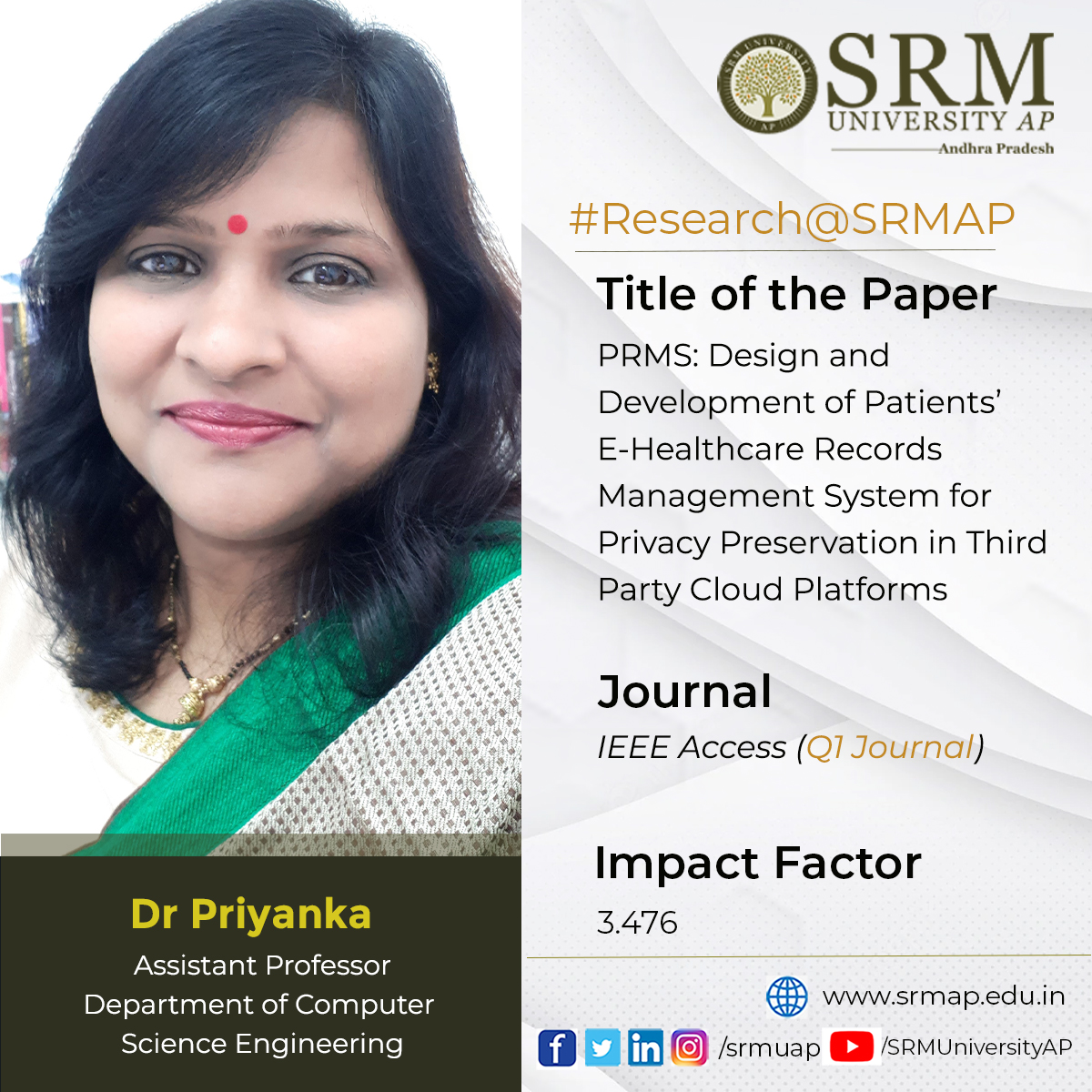 Publishing papers in Q1 journals is a remarkable accomplishment for research enthusiasts. Assistant Professor Dr Priyanka of the Department of Computer Science and Engineering published her latest research paper in the IEEE Access journal. The paper titled PRMS: Design and Development of Patients’ E-Healthcare Records Management System for Privacy Preservation in Third Party Cloud Platforms has an impact factor of 3.476. Kirtirajsinh Zala, Hiren Kumar Thakkar, Rajendrasinh Jadeja, Priyanka Singh, Ketan Kotecha, and Madhu Shukla co-authored the work with Dr Priyanka.
Publishing papers in Q1 journals is a remarkable accomplishment for research enthusiasts. Assistant Professor Dr Priyanka of the Department of Computer Science and Engineering published her latest research paper in the IEEE Access journal. The paper titled PRMS: Design and Development of Patients’ E-Healthcare Records Management System for Privacy Preservation in Third Party Cloud Platforms has an impact factor of 3.476. Kirtirajsinh Zala, Hiren Kumar Thakkar, Rajendrasinh Jadeja, Priyanka Singh, Ketan Kotecha, and Madhu Shukla co-authored the work with Dr Priyanka.Abstract
In the digital era, personal data storage on public platforms is a significant cause of concern with severe security and privacy ramifications. This is true especially in e-health data management since patients’ health data must be managed following a slew of established standards. The Cloud Service Providers (CSPs) primarily provide computing and storage resources. However, data security in the cloud is still a major concern. To overcome e-healthcare records privacy issues in a third-party cloud, we designed a Patient’s E Healthcare Records Management System (PRMS) that focuses on latency and throughput. Moreover, the proposed PRMS system is compared with Blockchain platforms such as Hyperledger Fabric v0.6 and Etherium 1.5.8 against latency and throughput by adjusting the workload for each platform up to 10,000 transactions per second. The proposed PRMS is compared to the Secure and Robust Healthcare Based Blockchain (SRHB) approach using Yahoo Cloud Serving Benchmark (YCSB) and small bank datasets. The experimental results indicate that deploying PRMS on Amazon Web Services decreases System Execution Time (SET) and the Average Delay (AD) time by 2.4%, 8.33%, and 25.15%, 15.26%, respectively. Deploying PRMS on the Google Cloud Platform decreases System Execution Time (SET) and Average Delay (AD) by 2.27%, 2.4%, and 2.72%, 4.73% AD, respectively.
Continue reading → - Facial recognition system August 23, 2022
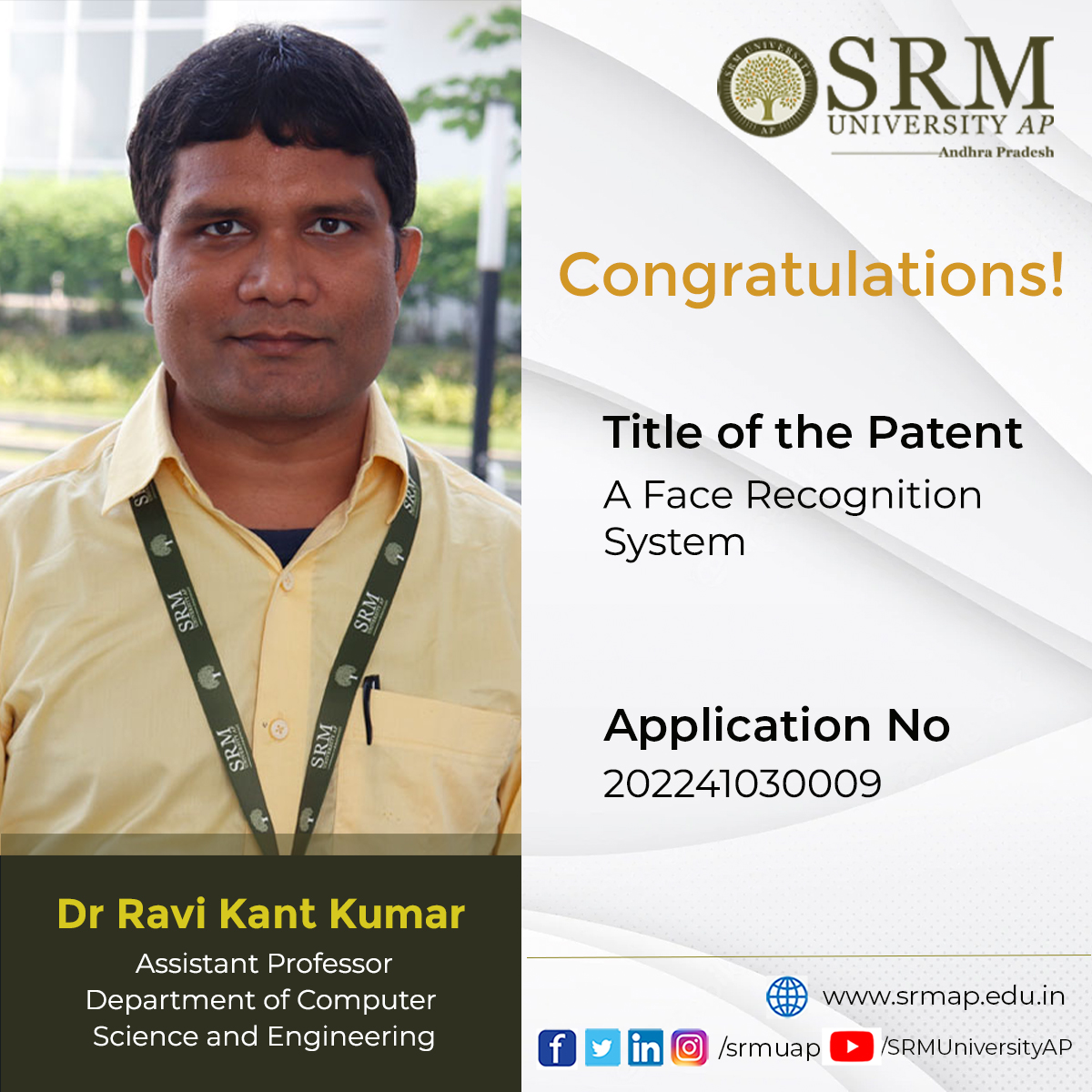 Assistant Professor Dr Ravi Kant Kumar of the Department of Computer Science and Engineering aspires to investigate and design the most effective face recognition system appropriate enough to recognise faces in various unconstraint environments. Recently, his patent application titled A Face Recognition System (Application number: 202241030009) got published. He collaborated with his BTech student Thota Venkata Saai Praneeth, for this project. Facial recognition systems have abundant applications in Face Identification, Automobile Security, Access Control, Immigration, Education, Retail, Healthcare, Image database investigations, Surveillance, and many more.
Assistant Professor Dr Ravi Kant Kumar of the Department of Computer Science and Engineering aspires to investigate and design the most effective face recognition system appropriate enough to recognise faces in various unconstraint environments. Recently, his patent application titled A Face Recognition System (Application number: 202241030009) got published. He collaborated with his BTech student Thota Venkata Saai Praneeth, for this project. Facial recognition systems have abundant applications in Face Identification, Automobile Security, Access Control, Immigration, Education, Retail, Healthcare, Image database investigations, Surveillance, and many more.Abstract
A facial recognition system is used for matching a human face captured in an image or a video frame with a database of faces. The system generally authenticates users by measuring facial features from the stored images. The present disclosure relates to face recognition systems. The envisaged system comprises a repository comprising a set of facial images of a plurality of subjects, a set of threshold values, and a plurality of rules. The system further comprises an image capturing unit for capturing a plurality of images of a subject’s face. A segmentation unit divides each image into a plurality of frames. The system further comprises a classifier that receives the frames and classifies frames containing faces from frames containing non-faces from the other frames. The facial features of each frame are extracted by an extractor. An analyser receives the extracted facial features and computes eigenvector values of the facial features of the frame. A comparator compares the computed eigenvector values with threshold values using the comparison rules to identify the subject.
Explanation of the research
Conventional facial recognition systems are configured to identify the contours of a person’s image captured by a camera or in real-time and compare it with the stored image to identify the person. However, external factors such as position, light conditions, camera calibration, and unconstraint conditions, among others, affect the identification of the face of the subject. Hence, comparing the faces with the help of the contours is not reliable. The present disclosure envisages a face recognition system. The system comprises a repository, an image capturing unit, a segmentation unit, a classifier, an extractor, an analyser, and a comparator. The repository consists of a set of facial images of a plurality of subjects, wherein the images define the subject’s facial features in different facial poses. Each image is tagged with an identity, a threshold integral value, and threshold eigenvector values corresponding to the facial features. The repository further comprises a first set of deep learning rules for classifying frames of a captured image into frames containing faces and frames containing non-faces, a set of extraction rules for extracting facial features from the frames 20 containing faces, the second set of deep learning rules for extracting eigenvector values of facial features of the frames containing faces. The repository additionally comprises a set of comparison rules for comparing eigenvector values of the captured facial features with the stored threshold eigenvector values to identify a subject’s face in the captured image.
- SRM AP to ink an MoU with the Rennes School of Business August 22, 2022
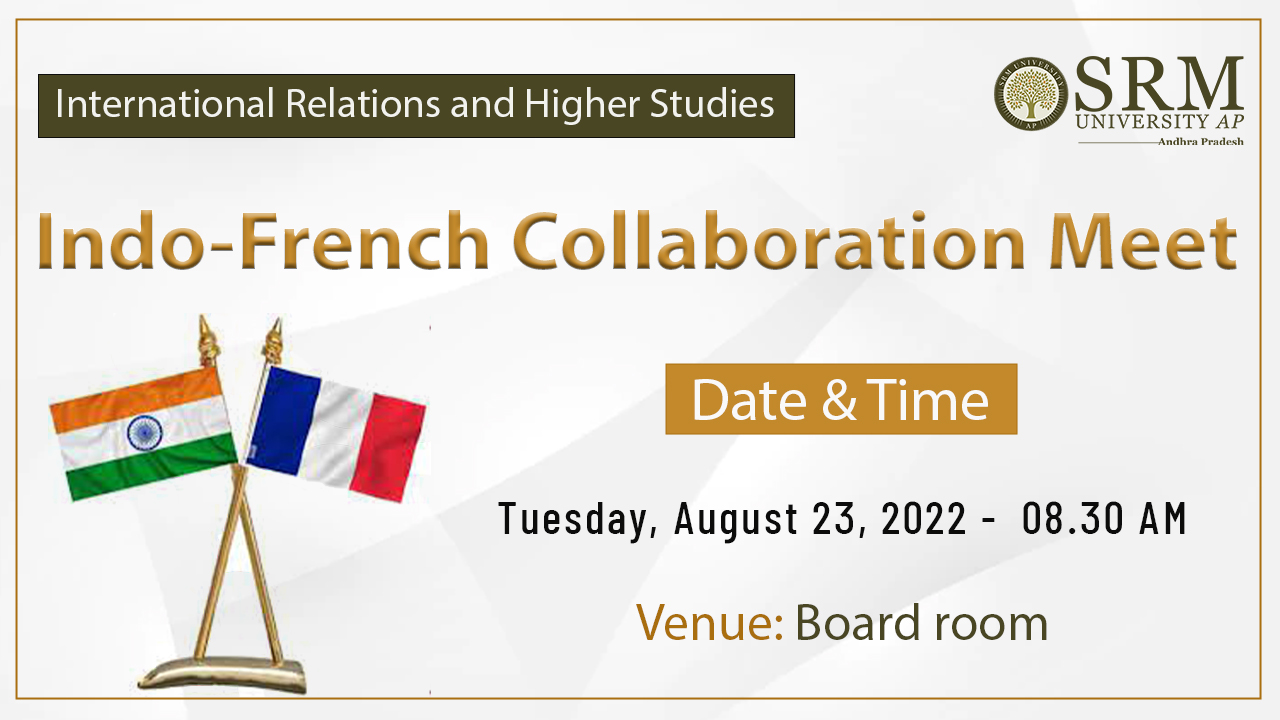 The diplomatic relations between India and France have been prevalent, and cooperation has developed in all major areas, including science and technology. Delegate visits are excellent opportunities to strengthen international partnerships and promote the mission of an educational institution. The Office of International Relations and Higher Studies is all set to host the Indo-French Collaboration Meet for inking an MoU with the Rennes School of Business.
The diplomatic relations between India and France have been prevalent, and cooperation has developed in all major areas, including science and technology. Delegate visits are excellent opportunities to strengthen international partnerships and promote the mission of an educational institution. The Office of International Relations and Higher Studies is all set to host the Indo-French Collaboration Meet for inking an MoU with the Rennes School of Business.Date: August 23, 2022
Time: 08.30 AM to 10.30 AM
Venue: Board room
The ceremony aims to to sign the Student Exchange Agreement. The visiting delegates are Dr Thomas Froehlicher, Dean, Rennes School of Business, and Ms Maud LE BARS, South Asia Area Manager Rennes School of Business. A meeting with Pro-Vice-chancellor Prof D Narayana Rao and the team will be held after an opening remark by the Hon’ble Vice Chancellor Prof V S Rao. There will be discussions regarding the collaboration and the road map ahead. Registrar Dr R Premkumar, DEAN of SEAMS Dr Bharadwaj, and Associate Director of IR&HS Dr Naga Swetha Pasupuleti will also grace the occasion with their august presence.
Continue reading → - You are the real heroes: Nobel Laureate Kailash Satyarthi to SRM AP students August 22, 2022
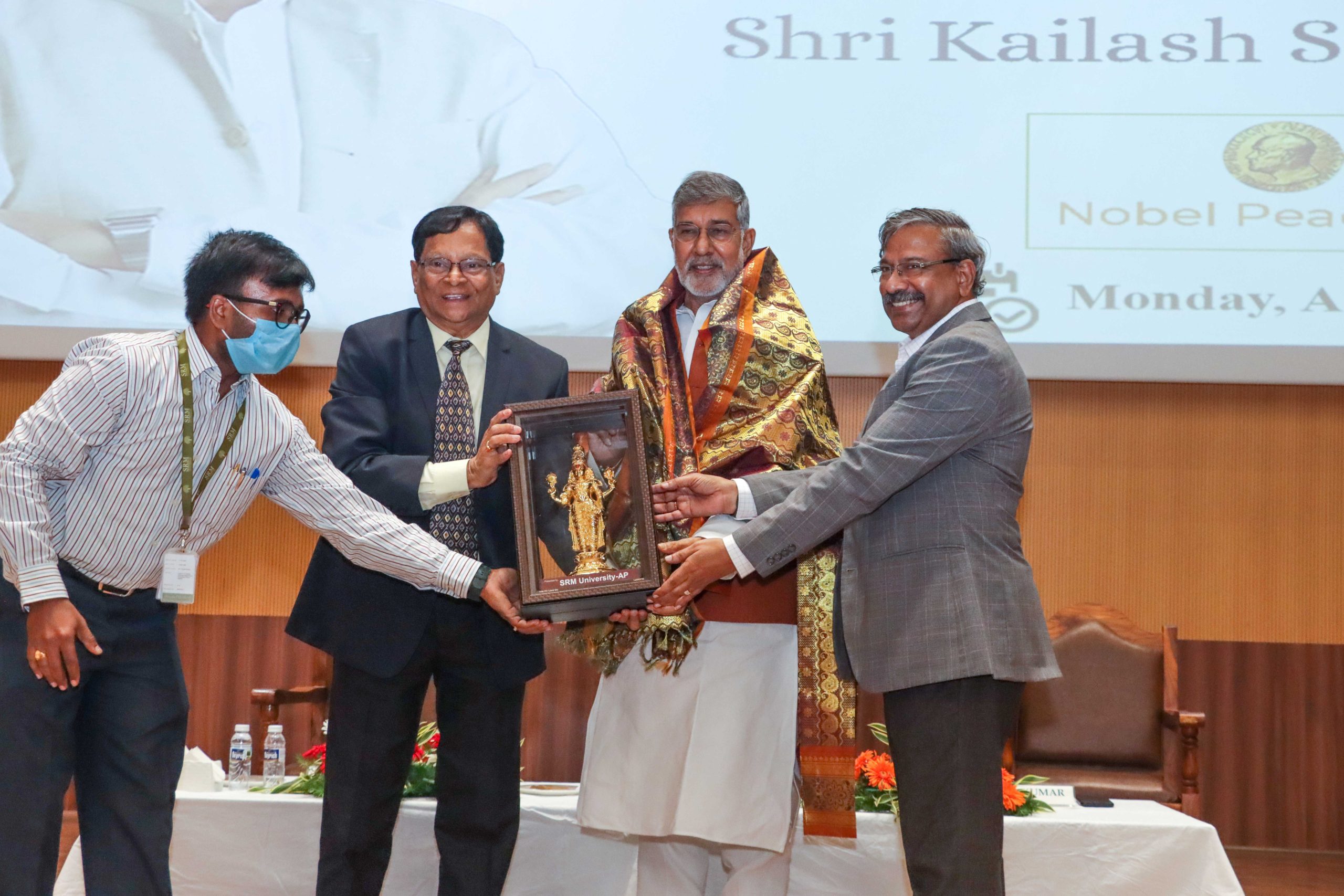 Nobel Peace Laureate Kailash Satyarthi addressed the students of SRM University-AP on the topic “Compassionate Youth Leadership: Key to Building a Better Future” on Monday, August 22, 2022. Vice-Chancellor Prof V S Rao, Registrar Dr R Premkumar, and other university dignitaries graced the occasion.
Nobel Peace Laureate Kailash Satyarthi addressed the students of SRM University-AP on the topic “Compassionate Youth Leadership: Key to Building a Better Future” on Monday, August 22, 2022. Vice-Chancellor Prof V S Rao, Registrar Dr R Premkumar, and other university dignitaries graced the occasion.“India may be a land of thousand problems, but India is also a mother of billion solutions; you are the solution, the real heroes, and the true makers of a new India”, said Shri Satyarthi, encouraging the students of SRM AP. He highlighted the significance of freedom and education in every child’s life and urged students to use their privilege of education to make this world a better place. Shri Kailash Satyarthi further called for the larger society of India to be the voice of several thousand children who have become the victims of child exploitation. The compassionate youth can work towards eliminating child slavery and make India a safe haven for every child.
“It is an honour and privilege to have with us one of the greatest thought leaders of our times, whose ideals and actions are revered and respected all over the world”, said Vice-Chancellor Prof V S Rao welcoming the honourable guest. He further emphasised the university’s vision to disseminate transformative education and enable its students to be conscientious citizens who can play an instrumental role in nation-building.
Shri Satyarthi acknowledged the contributions of SRM educational institutions toward moulding knowledgeable and passionate youth. Beyond its quality of education, he also admired the university for diffusing the values of humanity and compassion among the student community. He further recounted the story of children he rescued who pursued their education in SRM educational institutes. Shri Satyarthi reinstated the power of compassion in transforming the individual into a change maker and the need for education to ignite the spirit of compassion in every student’s mind. The renowned child rights activist who has been pivotal in the rescue of over 1 lakh children from forced labour and slavery is reckoned the world over for spearheading Bachpan Bachao Andolan, Kailash Satyarthi Children’s Foundation, Global March Against Child Labour, 100 Million Campaign and several other initiatives to fight against the injustices perpetrated against children worldwide and advocated for the universal right of Children’s education.
An interactive session was organised following the event where the students and faculty had a brief dialogue with the Nobel Laureate. Registrar Dr R Premkumar proposed the vote of thanks on behalf of the university to Shri Kailash Satyarthi for accepting the invitation and visiting SRM University-AP.
In Media: Press Coverage Continue reading → - Systematic bibliographic research on eutrophic-ecological models August 22, 2022

The Department of Civil Engineering is delighted to announce that Dr Siddhant Dash has published a paper titled “Systematic bibliographic research on eutrophication-based ecological modelling of aquatic ecosystems through the lens of science mapping” in the journal “Ecological Modelling” having an Impact Factor of 3.512. This research was conducted in collaboration with Prof Ajay S Kalamdhad from IIT Guwahati.

This research is a systematic approach on reviewing the published literature on eutrophic-ecological models developed worldwide and the methods associated with them. This provides critical insights into the status of the research domain, thereby providing a direction for the practising and future researchers to undertake a research career in this domain. It offers a more comprehensive and holistic approach to the critical review of the published literature, providing a deeper understanding to the researchers regarding the existing practices of developing eutrophication-based ecological models and the prospects lying ahead. His future research plans include understanding carbon and nutrient dynamics within an aquatic ecosystem.
Abstract of the Research
When water bodies receive surplus nutrients, especially nitrates and phosphates, these nutrients stimulate excessive plant growth (eutrophication), including harmful algal blooms, leading to oxygen depletion, decreased biodiversity, changes in species composition and dominance, and degradation of water quality. Although there are natural causes, much of the eutrophication today results from inadequately treated wastewater and agricultural runoffs. Population pressure, urbanization and industrialization contribute a considerable amount of waste, which alters the physio-chemical quality of water that eventually upsets the biotic components of the aquatic system. It is important to note that though pollution has been a significant factor in degrading the quality of aquatic ecosystems, the lack of management and global awareness regarding the protection and conservation of water bodies worldwide cannot be neglected. Hence, there lies an inherent sense of responsibility to restore the aquatic ecosystems to their natural state. Numerous techniques/treatment options are available for varying conditions, such as climatic factors, socio-economic factors, and so on. However, before ascertaining a treatment alternative to curb eutrophication levels, understanding the dynamics of any independent aquatic ecosystem is of prime importance. This necessitates a reliable model, which can provide information regarding the physical processes and dynamic occurrences in the eutrophic water bodies. Ecological modelling refers to the formation of dynamic and complex relationships between the organisms found in the ecosystem and the surrounding. It attempts to unravel the effects of certain relationships in the ecosystem that are not so apparent at first glance. The present study provides a scientific investigation of a detailed review of the published works in the domain of eutrophication-based ecological modelling till the year 2020. The first step was the scientometric studies, which were followed by a qualitative assessment wherein the current trends in research were discussed. This was followed by identifying the critical gaps in research to provide future direction.
Fig. 1. Ecological modelling process
Fig. 2. Description of the three-step literature review process employed in this research
Continue reading → - Effect of grass clippings on anaerobic co-digestion of food waste August 22, 2022
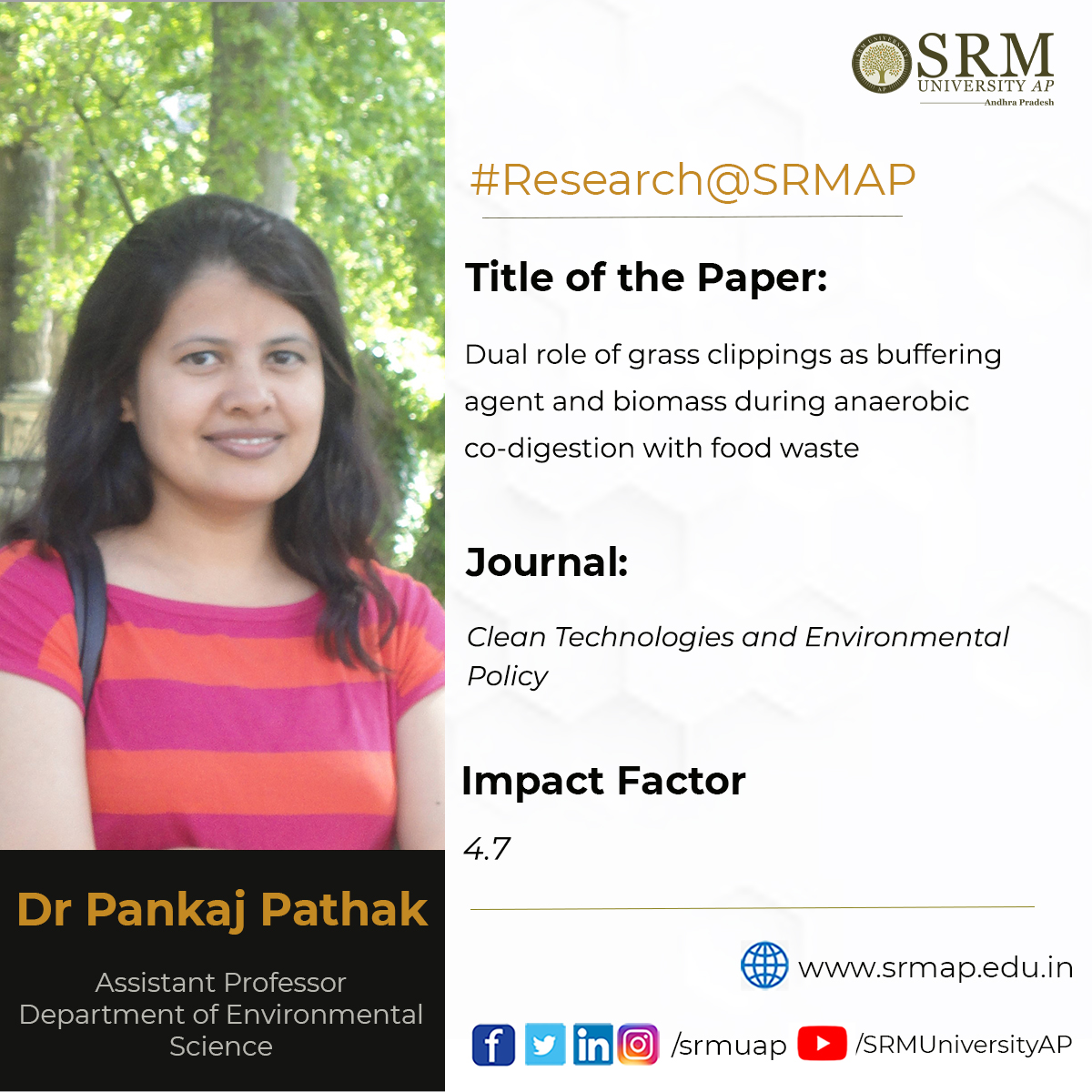 The different dimensions of sustainable waste management have always been explored by researchers all over the world. Assistant Professor Dr Pankaj Pathak, Department of Environmental Science, has been actively involved in this research area for a while. Her paper titled Dual role of grass clippings as buffering agent and biomass during anaerobic co digestion with food waste is published in the journal Clean Technologies and Environmental Policy with an impact factor 4.7. Dr Pankaj Pathak co-authored the paper with Debkumar Chakraborty, Sankar Ganesh Palani, M M Ghangrekar, and N Anand.
The different dimensions of sustainable waste management have always been explored by researchers all over the world. Assistant Professor Dr Pankaj Pathak, Department of Environmental Science, has been actively involved in this research area for a while. Her paper titled Dual role of grass clippings as buffering agent and biomass during anaerobic co digestion with food waste is published in the journal Clean Technologies and Environmental Policy with an impact factor 4.7. Dr Pankaj Pathak co-authored the paper with Debkumar Chakraborty, Sankar Ganesh Palani, M M Ghangrekar, and N Anand.Abstract
There is a dire need to replace the chemical buffers that regulate the redox environment in single-stage anaerobic digestion of food waste. Hence, the applicability of grass clippings as an eco-friendly buffering agent and biomass during the anaerobic co-digestion of food waste was explored. A focus was primarily given on the effects of grass clippings on the redox environment and acidogenesis. Concomitantly the production of volatile fatty acids, hydrogen, and methane in mesophilic conditions was monitored. Organic load and substrate-to-inoculum ratio were kept constant in all the experiments, and no chemical buffer was used. The results revealed that the redox environment was regulated with 10% grass clippings by inhibiting rapid pH drop in the digester. The addition of 2, 4, and 6% grass clippings promoted acidogenesis with increased production of acetic and butyric acids, whereas 8 and 10% grass clippings promoted solventogenesis with ethyl alcohol production. Hydrogen generation from the experiments with grass clippings was in the range of 27–30% of the total biogas, which was marginally higher than the control (25%). Methane concentration was negligible in the biogas generated from all experiments. The acidification rate, VFA production/consumption rate, specific hydrogen yield, hydrogen conversion efficiency, and volatile solids removal were maximum and minimum in the reactors with 6 and 10% grass clippings, respectively. From the above results, it can be concluded that adding grass clippings to food waste would regulate the sudden pH changes and enhance the production of value-added biochemicals, making the process cost-effective.
Continue reading → - The prospects and challenges in India-ASEAN relations August 22, 2022
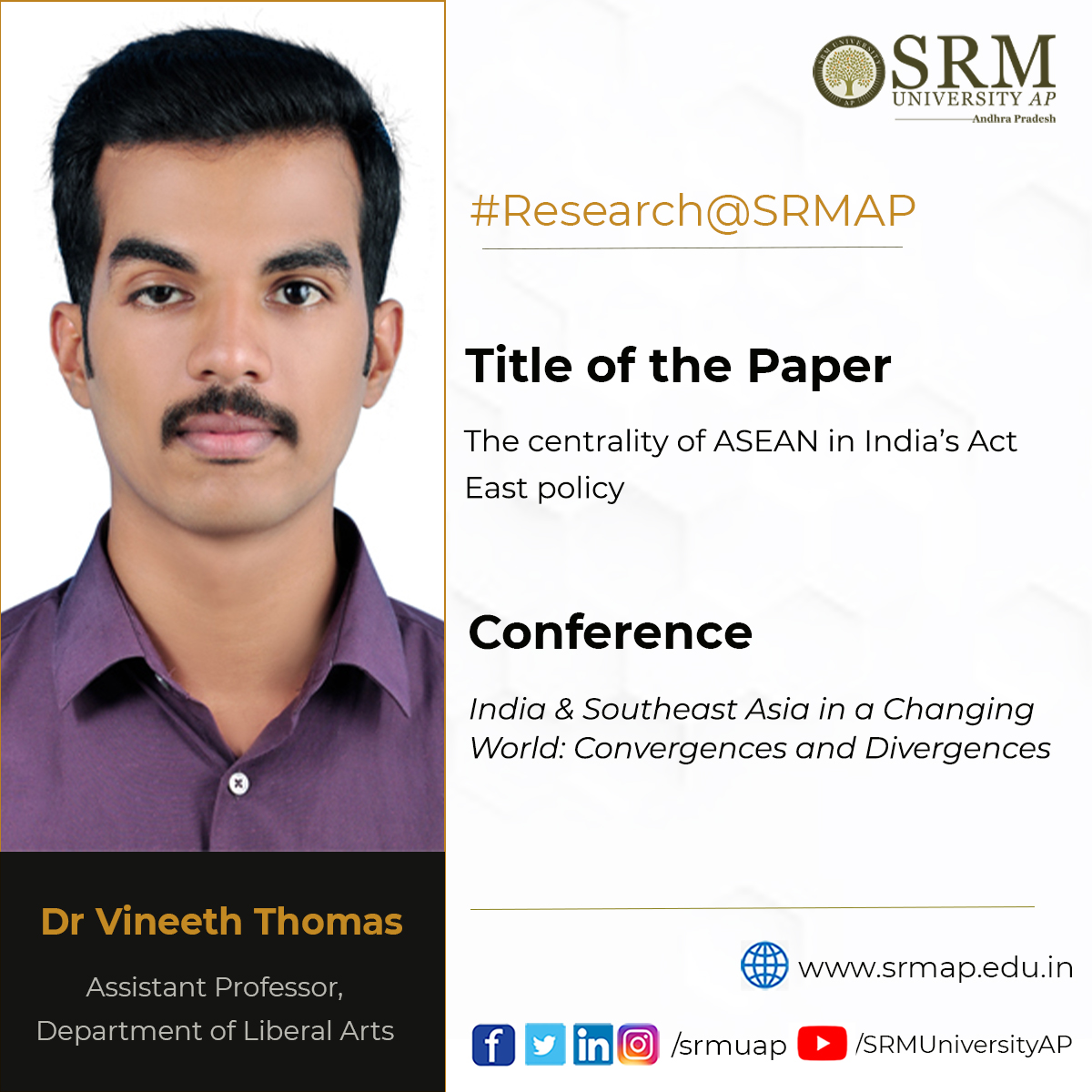 The upcoming international conference, India & Southeast Asia in a Changing World: Convergences and Divergences, will examine India’s Act East policy, investigating its prospects and challenges in the Southeast Asian region. Assistant Professor Dr Vineeth Thomas from the Department of Liberal Arts has been selected for presenting a paper at this Conference organised by Christ University, Delhi NCR. He will present the paper titled The centrality of ASEAN in India’s Act East policy at the conference.
The upcoming international conference, India & Southeast Asia in a Changing World: Convergences and Divergences, will examine India’s Act East policy, investigating its prospects and challenges in the Southeast Asian region. Assistant Professor Dr Vineeth Thomas from the Department of Liberal Arts has been selected for presenting a paper at this Conference organised by Christ University, Delhi NCR. He will present the paper titled The centrality of ASEAN in India’s Act East policy at the conference.The international conference will be held In-Person from 14 to 15 October 2022 at the CHRIST (Deemed to be University) Delhi-NCR campus. The Hanns Seidel Foundation funds this conference. The major focus area of the conference is India’s foreign policy towards ASEAN countries like Myanmar, Thailand, Malaysia, Vietnam, Indonesia, and Singapore
Abstract
Against the backdrop of multi-dimensional developments and interventions in the Indo-Pacific region, India’s overseas policy and national security apprehensions have undergone substantial changes in the past few decades. Starting with the Look East Policy in the 1990s, India advanced its policy in 2014 as Act East Policy. The potential benefits of bilateral and multilateral relations in the Indo-pacific region made India take up its partnership with the Association of Southeast Asian Nations (ASEAN) seriously, which provided an opening and strip for India to explore Southeast Asia. This paper evaluates the significance of keeping ASEAN at the heart of India’s Act East Policy by illustrating the prospects and challenges in India-ASEAN relations.
Continue reading →


